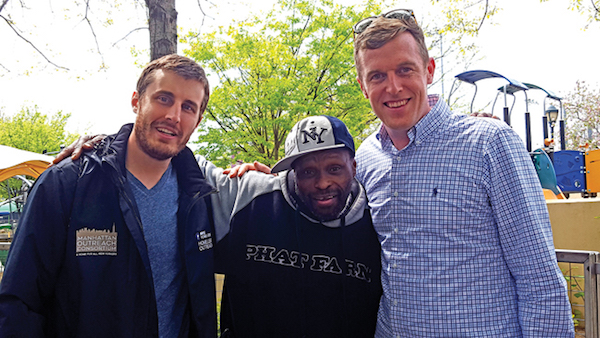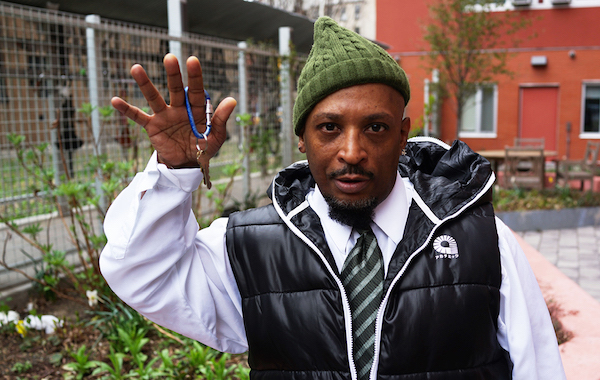
BY DUSICA SUE MALESEVIC | Robert’s brown eyes smiled when he talked about his home of around two and a half years. After living on the street, the apartment “saved my life,” Robert said. “I was so happy I didn’t know what to do.”
The only downside: He couldn’t bring his cats.
An outreach team from Breaking Ground — a nonprofit that works to bring the homeless inside and get them housed — talked with Robert when he was living on the street in Bedford-Stuyvesant, got him into transitional housing at a YMCA, and eventually placed him at a new development in the Bronx, Robert, 53, told Chelsea Now.
On Thurs., April 27, the sun decided to make an appearance after a day of rain, and Robert was near the entrance of the Chelsea Waterside Park at W. 23rd St. and 11th Ave. He said he had walked from the Bronx — in the rain — to Chelsea with his two carts that brimmed with bottles and cans.
Breaking Ground Assistant VP for Housing Operations and Programs, Doug Becht, along with Breaking Ground Operations Manager Bryan Tarabochia, had approached Robert as part of their outreach that afternoon, and this newspaper tagged along as they worked. Becht, who is also a licensed master social worker, gave Robert his cellphone number as they talked.
Robert spoke about being a loner before, and living at the building has given him a sense of community as he is “trying not to be alone.” He declined to say how long he had been homeless, but Becht said that it was at least a year.
Becht pointed out that there might be the assumption that Robert is homeless, but said, “The perception doesn’t meet the reality as workers.” As part of doing outreach, it is important not to make assumptions, and he said it was good that they checked in with Robert. “There’s a value in coming out here,” he said.
Department of Homeless Services (DHS) Outreach Program Administrator Heather Frey — of the department’s Street Homelessness Solutions division — also came out that Thursday afternoon. “There is such a misconception that everyone you see outside is homeless,” said Frey, who noted people are creatures of habit, and for someone who had been on the streets for years, they understand the rhythms of it. “It’s not a crime to be homeless,” she said. “And perception is not always reality.”
Tarabochia said, “Housing is a big adjustment for people who have been on the street.” Becht concurred, saying it takes a lot of courage to get services and to be housed. But, “When people go into supportive housing, they stay,” Becht said, noting that there is a retention rate of 95 percent for those in permanent housing.
Breaking Ground CEO and President Brenda Rosen explained that “supportive housing” is affordable housing that comes with services such as medical and mental health care, substance abuse referrals, and other programs such as financial literacy.
Breaking Ground, which Rosen noted is also a real estate developer, has more than 3,000 units of permanent supportive housing. About 40 to 50 percent of the units go to low-income working class individuals and around 50 to 60 percent are reserved for the formerly homeless, she said in an April 28 phone interview. There is no requirement for someone to be clean or sober, she said. “We feel strongly that having a place is the first step to recovery,” Rosen said.
Breaking Ground (breakingground.org) was once known as Common Ground, and it started in the early 1990s when the organization rehabilitated a dilapidated former welfare hotel at W. 43rd St. and Eighth Ave., she explained. In late 2015, the nonprofit changed its name from Common Ground to Breaking Ground, said Rosen, who has been CEO since the summer of 2011.
Breaking Ground is part of the Manhattan Outreach Consortium, which was established (and is lead) by Goddard Riverside, according Becht and to Goddard’s website (goddard.org/grcc/programs/HomelessOutreach).
Goddard Riverside has a contract with the DHS, and Breaking Ground is subcontracted.
Working with other nonprofits, “The goal of all of it is the same — bring people inside,” Rosen noted. Breaking Ground and their partners send outreach teams to several parts of the city, covering Brooklyn and Queens, and from 10th to 59th Sts. from river to river in Manhattan. “We touch thousands of people a year,” Rosen said, adding that the outreach teams establish relationships and work with homeless individuals within their time frame.

Tarabochia, who has been with Breaking Ground for about two and a half years, said that they generally see more activity at Chelsea Piers and Chelsea Waterside Park when the weather is nice. Along the West Side Highway, west of the soccer field, there is activity as well, he said. The outreach team also spends time with their canvassing efforts in Hudson Yards and Hell’s Kitchen, and helped with an encampment at W. 35th St. at Dyer Ave. (btw. Ninth & 10th Aves.), as Chelsea Now reported late last year (“In Midtown South, Outreach to Homeless Expands”).
“We managed to get a number of people into our caseload,” Tarabochia said of those efforts.
“We have an agenda but at the same time we let them get there at their speed,” Becht noted. Persistence, consistency and respect are important when creating a rapport with those who are homeless. “A lot of outreach is about repeated contact,” Tarabochia said, noting that it might take years to get someone inside.
Becht said building a rapport is a combination of things: the frequency and quality of the interactions, giving the person appropriate space and using body language that signifies that the person is an equal. In some instances, people are clearly malodorous, and not making a face or covering one’s nose shows the respect that can make someone feel comfortable, he said. It is also important that staff is interested and genuinely cares, he said.
When someone is living with mental illness, Becht said that heightens the importance of the approach, and it emphasizes all the principles of engagement. There is that much less room for the outreach team to gain trust with that individual, he said, who may disengage more quickly.
“Once we get the foot into the door, that’s when the progress starts,” Becht said.






























